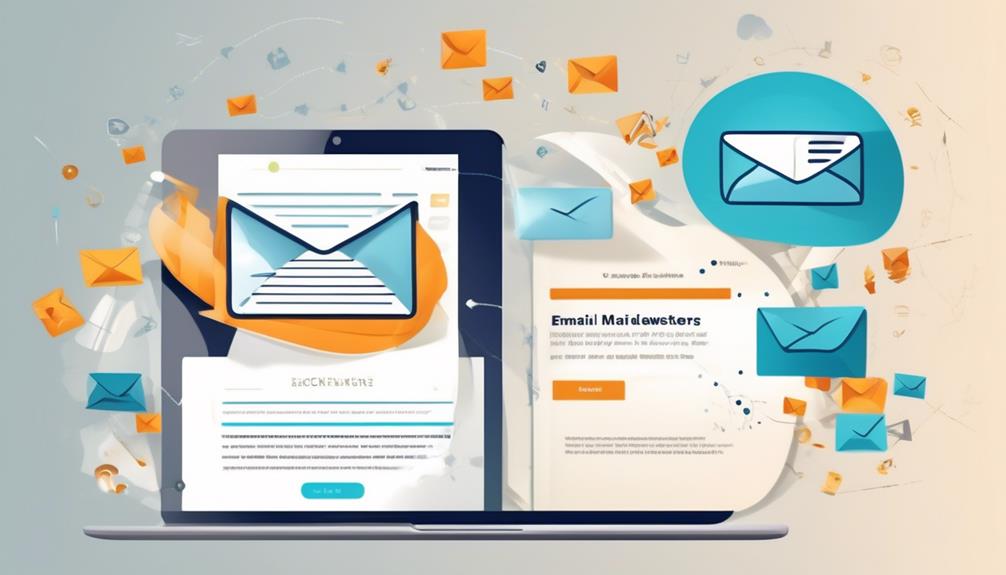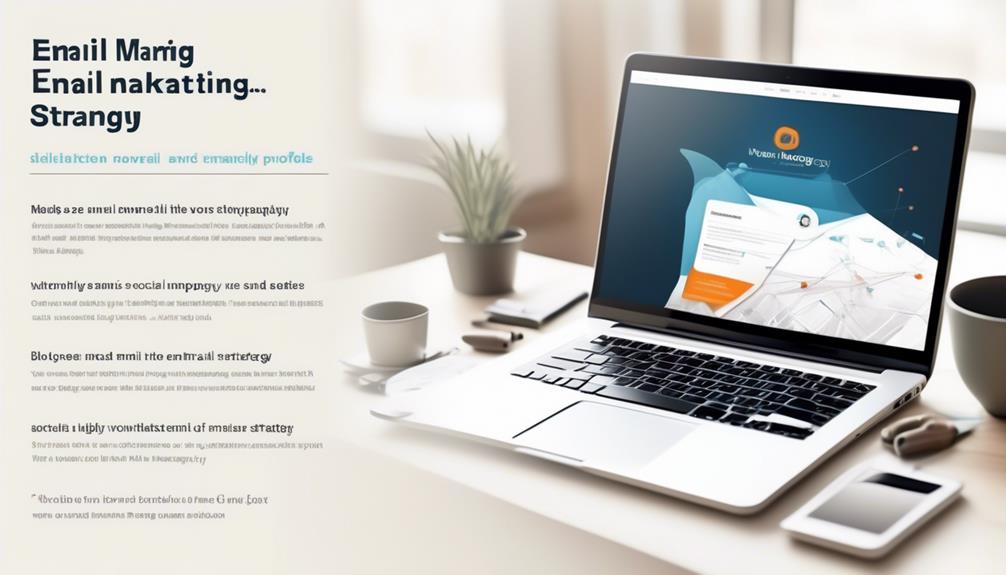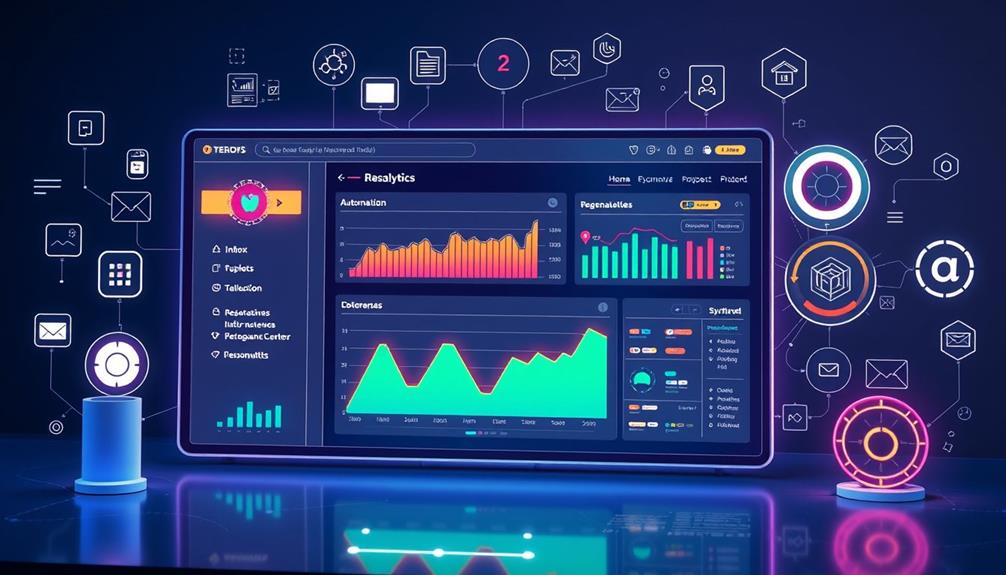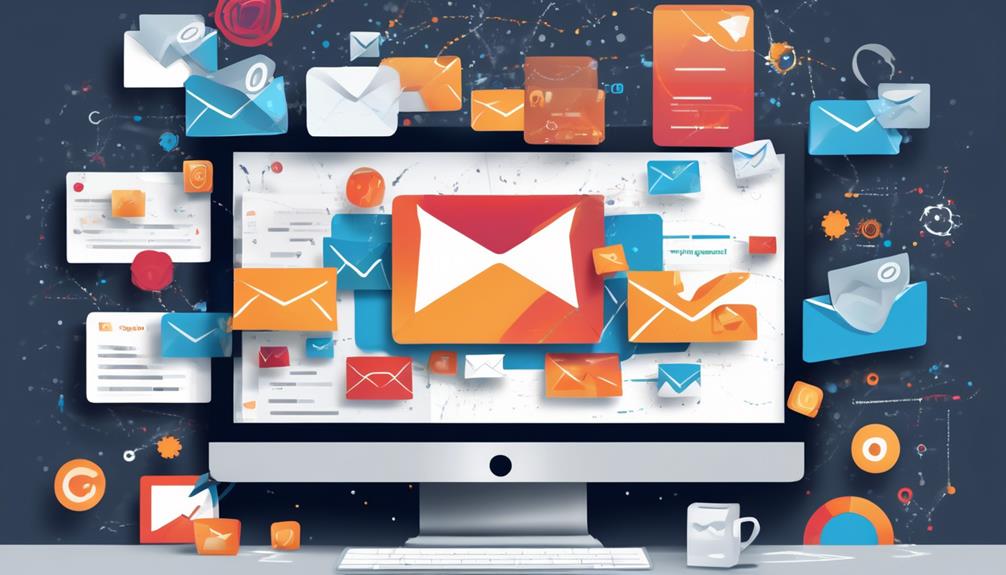Many people are not aware that email marketing is considered as owned media, giving companies substantial control and autonomy over their communications. However, is that really true?
As we explore the concept of owned media and its implications for email marketing, we'll uncover the nuances and benefits that position it as a crucial component of a brand's digital strategy.
Understanding the dynamics of owned media and its relationship to email marketing can provide valuable insights for businesses seeking to maximize their outreach efforts.
Key Takeaways
- Owned media, including email marketing, allows brands to have control over their brand messaging and audience engagement.
- Email marketing aligns with the definition of owned media in a comprehensive marketing strategy, as it grants brands direct communication with their audience and control over content and delivery.
- Email marketing offers personalized communication, higher engagement, and conversion rates, making it an effective tool for nurturing leads and driving conversions.
- Integrating email marketing with owned media channels enhances brand recognition, trust, and audience engagement, while also delivering a unified message across various platforms.
Understanding Owned Media
We believe that understanding owned media is fundamental for developing a successful marketing strategy, as it grants us complete control over our brand messaging and audience engagement. Owned media encompasses the content created and distributed by our brand, allowing us full control over the platform, audience, and content. This control is crucial for shaping our brand's narrative and fostering meaningful engagement with our audience.
Key owned media channels, such as websites, blogs, apps, and email marketing, offer us the opportunity for personalized content delivery and community building. By leveraging these platforms, we can tailor our messaging to resonate with our audience and cultivate a loyal following. Crafting an owned media process involves meticulous pre-planning, content strategy development, content creation workflow, distribution, and measurement. This ensures that our content delivery remains consistent and effective.
Embracing best practices for owned media success, such as creating high-quality, value-driven content and optimizing for search engines, empowers us to engage with our audience and collaborate with influencers. By acting as an industry publication firm, we can provide valuable insights and establish ourselves as a reputable source within our field. Understanding owned media not only allows us to control our brand's narrative but also to build a robust presence across various platforms, including social media, and email marketing.
Characteristics of Owned Media

Characteristics of owned media encompass the distinctive attributes that define the brand's control over content creation and distribution, shaping audience engagement and platform utilization. In the realm of digital marketing, owned media provides brands with complete control over the messaging and delivery channels. This level of control allows for strategic content creation tailored to the brand's identity and objectives.
When considering email marketing, owned media characteristics are evident in the ability to curate and disseminate content directly to a brand's audience without reliance on third-party platforms. This control over distribution channels enables brands to shape the narrative and maintain consistency in their messaging.
Furthermore, owned media grants brands the autonomy to dictate the cadence and timing of content delivery, optimizing audience engagement. The characteristics of owned media also extend to the brand's ability to cultivate and nurture its audience, fostering a sense of loyalty and connection. By leveraging owned media, brands can strategically position themselves in the digital landscape while maintaining a direct line of communication with their audience.
Understanding these characteristics is essential for brands seeking to maximize the potential of their owned media channels, such as email marketing, in their overall digital marketing strategy.
Email Marketing as Owned Media
As we consider the role of email marketing within owned media, it's important to recognize the distinct benefits it offers. By leveraging email marketing, brands can directly engage with their audience, maintaining control over both content and delivery.
This aspect aligns with the definition of owned media, highlighting its significance in a comprehensive marketing strategy.
Email Marketing Benefits
Email marketing's status as owned media empowers businesses with complete control over content, audience, and platform, leading to personalized communication and higher engagement and conversion rates.
By curating an email list, businesses can tailor content to specific segments of their audience, driving increased relevance and engagement. This targeted approach also enhances brand awareness and loyalty, as subscribers receive valuable, tailored content.
Moreover, email marketing allows for the strategic planning and execution of marketing campaigns, enabling businesses to nurture leads and drive conversions. The high return on investment (ROI) associated with email marketing further underscores its significance, as it remains a cost-effective method for reaching a global audience.
With a well-crafted content strategy, businesses can leverage email marketing to build lasting relationships with customers and drive measurable results.
Owned Media Definition
After establishing the significance of email marketing as a cost-effective and personalized communication tool, it's essential to understand how it fits within the broader concept of owned media.
Owned media, including email marketing, allows brands complete control over the content, audience, and platform. This control offers the ability to tailor content formats and digital media activities to suit specific marketing objectives.
Email marketing, as a form of owned media, enables direct communication with the audience, facilitating a pull marketing strategy. By investing in owned media channels such as websites, blogs, apps, and email marketing, brands can effectively promote new content and product updates.
This control over the content and marketing channels positions owned media, including email marketing, as a reliable choice amidst uncertainties and costs associated with paid ads and earned media.
Benefits of Email Marketing

Email marketing offers a cost-effective means of communication, enabling targeted audience reach and measurable campaign performance.
By directly engaging with subscribers, we can tailor messages to resonate with their specific interests and needs, leading to higher conversion rates.
Additionally, the ability to track and analyze campaign performance provides valuable insights for optimizing future strategies and maximizing ROI.
Cost-Effective Communication
When implementing a cost-effective communication strategy, email marketing emerges as a powerful tool for direct outreach to a targeted audience. It offers a high return on investment (ROI) and broad reach, making it an efficient way to communicate with customers.
Moreover, email marketing allows for personalized and tailored messaging, thereby enhancing engagement and conversion rates. Additionally, the minimal production and distribution costs associated with email marketing make it a budget-friendly communication option.
Furthermore, the availability of metrics and analytics tools enables the measurement of email marketing performance, allowing for continuous improvement and optimization.
- High ROI and broad reach
- Efficient communication with customers
- Personalized and tailored messaging
- Minimal production and distribution costs
- Budget-friendly communication option
- Metrics and analytics tools for performance measurement
Targeted Audience Reach
Expanding on the cost-effective communication strategy, email marketing's targeted audience reach amplifies its effectiveness by enabling tailored messaging to specific segments, fostering enhanced engagement and conversion rates. By reaching specific segments of our audience, we can deliver relevant content and offers, improving the overall effectiveness of our marketing efforts. This personalized communication fosters stronger relationships with customers and prospects, ultimately enhancing brand loyalty. Through precise segmentation and automation, we can ensure more personalized and timely communication with recipients, guiding them through the buyer journey. To illustrate the impact of targeted audience reach, consider the following comparison table:
| Marketing Channel | Targeted Audience Reach | Automation Capability |
|---|---|---|
| Email Marketing | High | Yes |
| Social Media Accounts | Low | Limited |
| Leased Media | Varies | No |
In considering best practices, it's clear that email marketing's targeted audience reach offers a distinct advantage in engaging and converting prospects.
Measurable Campaign Performance
By harnessing the power of measurable campaign performance, we can gain valuable insights into the effectiveness of our email marketing efforts, ultimately driving strategic decision-making and optimizing for better results.
When delving into measurable campaign performance in email marketing, we uncover the following benefits:
- Real-time Tracking and Reporting
- Allows for data-driven decision-making and optimization for improved outcomes.
- Segmentation and Personalization
- Leads to higher engagement and conversion rates, driving business growth through targeted messaging.
The ability to track and analyze key metrics such as open rates, click-through rates, and conversion rates provides a solid foundation for refining strategies and enhancing the overall impact of our email marketing initiatives. This level of control over the content and its performance sets email marketing apart as a significant aspect of owned media, contributing to its effectiveness in the marketing mix.
Limitations of Email Marketing

Despite its many advantages, email marketing encounters several limitations that can hinder its effectiveness as a marketing channel. One of the key challenges is its potential limitation in reaching a broader audience. The success of email marketing heavily relies on the size and engagement level of the email list, which can restrict the overall reach of the campaign. Additionally, deliverability issues, such as emails being filtered as spam or not reaching the intended recipients' inboxes, can significantly impact the effectiveness of email marketing efforts.
Furthermore, the risk of unsubscribes and opt-outs poses a limitation to consistently engaging with the audience. Unlike other marketing channels, email marketing may also have limitations in terms of visual impact and creativity. This can restrict the ability to capture and maintain the audience's attention effectively.
Moreover, email marketing effectiveness is susceptible to evolving privacy regulations and data protection laws, which can limit the collection and utilization of customer data for targeting and personalization.
Considering these limitations, it's crucial to understand the constraints of email marketing within the media model, particularly in comparison to owned, granted, and rented media, to effectively leverage this marketing channel to reach an audience.
Integration With Owned Media Strategy

Understanding the limitations of email marketing, we can now explore its integration with owned media strategy to enhance brand consistency and audience engagement.
When integrating email marketing with owned media strategy, several key benefits become apparent:
- Cohesive Brand Experience: Aligning email marketing with other owned media channels such as websites, blogs, and apps ensures a consistent brand experience across all touchpoints. This consistency fosters brand recognition and trust among the audience.
- Seamless Content Promotion: Leveraging owned media strategy allows for the seamless promotion of new content and product updates through email marketing, websites, and social media presence. This integrated approach ensures that the audience receives a unified message regardless of the channel they engage with.
Best Practices for Email Marketing

When implementing email marketing, it's essential to adhere to best practices that encompass segmentation, personalization, responsive design, compelling subject lines, and effective calls-to-action to optimize audience engagement and drive conversions.
Segmentation and personalization enable the delivery of targeted content to specific audience segments, increasing relevance and engagement.
Responsive design ensures that your email content is easily accessible and visually appealing across various devices, enhancing the user experience.
Compelling subject lines are crucial for capturing the recipient's attention and increasing open rates.
Additionally, including effective calls-to-action encourages recipients to take the desired actions, ultimately driving conversions.
Regularly analyzing and optimizing email performance based on key metrics such as open rates, click-through rates, and conversion rates is crucial to refining your email marketing strategy.
This data-driven approach allows for continuous improvement and ensures that your email content remains relevant and impactful.
Measuring Email Marketing Success

Measuring the success of email marketing involves tracking various metrics such as open rates, click-through rates, conversion rates, and engagement levels to evaluate the effectiveness and impact of our efforts. When analyzing the performance of our email campaigns, it's essential to consider the following:
- A/B Testing: Experimenting with different elements of email campaigns, such as subject lines and content, provides valuable insights into audience preferences and contributes to better email marketing success.
- Segmentation and Personalization: Tailoring content distributed through email marketing to specific segments based on demographics, behavior, or preferences is crucial for improving performance metrics and enhancing the impact of our owned media strategy.
Is Email Marketing Considered Owned or Paid Media?
When it comes to digital marketing, email marketing is considered owned media. This means that the company has full control over the content and distribution of email campaigns. On the other hand, paid media includes advertising and promoting content through channels like social media and search engines.
Frequently Asked Questions
What Is Included in Owned Media?
Owned media encompasses content created and distributed by the brand to its audience. This can include the brand's website, blog, email marketing, forums, and social media presence.
The process of owned media involves several stages. It starts with pre-planning, where the brand identifies its goals and target audience. Then, a content strategy is developed to guide the creation and distribution of content.
The creation workflow is an important part of owned media, as it involves actually producing the content. This can include writing blog posts, designing graphics, or creating videos.
Once the content is created, it is distributed through various channels such as social media platforms or email campaigns.
Measurement is another crucial aspect of owned media. Brands need to track metrics such as website traffic, social media engagement, and email open rates to assess the effectiveness of their content and make improvements if necessary.
To achieve success with owned media, there are some best practices to follow. Brands should focus on creating high-quality, value-driven content that resonates with their audience. They should also invest in search engine optimization to improve their visibility in search engine results. Building audience engagement through interactions and conversations is important, as is collaborating with influencers to expand the reach of the brand's content.
Is Direct Mail Paid or Owned Media?
Direct mail is considered owned media. It encompasses content created by the brand and distributed to an audience developed by the brand. This allows us to have complete control over the content and the properties it's distributed on, aligning with our marketing strategy of providing high-quality, value-driven content.
Understanding the distinctions between paid, owned, and earned media is crucial for our marketing success, empowering us to adapt to the customer journey.
Is Email Marketing Digital Media?
Yes, email marketing is an essential component of digital media. It allows brands to create and distribute content to their audience, offering high ROI and user base potential.
This channel provides control over content and distribution platforms, making it a significant aspect of owned media.
Understanding email marketing as digital media is crucial for a comprehensive marketing strategy.
Does Marketing Fall Under Media?
Marketing is a vital component of media, serving as a strategic tool for engaging audiences and achieving organizational goals.
It involves crafting compelling messages and delivering them through various channels to influence consumer behavior.
This multifaceted approach ensures that the brand's voice is heard and resonates with the target audience.
Conclusion
In conclusion, email marketing is a powerful owned media channel with high potential for return on investment.
Research shows that for every $1 spent on email marketing, the average return is $42. This statistic highlights the significant impact and effectiveness of email marketing in reaching and engaging with a wide audience.
By integrating email marketing into your owned media strategy and following best practices, you can maximize its benefits and drive success for your brand.










